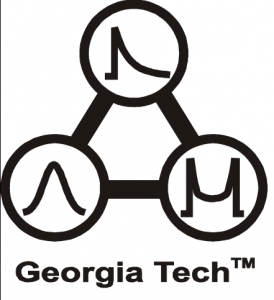Where did the GT Prop Group’s logo come from and what does it mean?

The logo was formulated in 2003 as part of the newly launched GT Prop Group laboratory. The three bubbles joined by three bars represent the three main domains that an electrical engineer specializing in propagation must work in: time, space, and frequency. The three bubbles are filled with three common power spectral densities describing propagation in complicated, stochastic media. These simple shapes bely some very sophisticated concepts in radio wave propagation and electrical engineering in general.
For time-varying channels, the lower-left bubble has a Gaussian Doppler spectrum. The Doppler (frequency) domain is the spectral compliment of the time domain. The Gaussian spectrum is useful for characterizing typical time-variations because of its symmetrical shape that tapers dramatically away from its center. Faster-moving scatterers displace frequency more dramatically in the Doppler domain, but are less common or large. In other words, the bigger something is, the more it scatters but the less likely it is to move.
For frequency-varying channels, the upper bubble has an exponential delay spectrum. The delay domain is the spectral compliment of the frequency domain. The exponential spectrum is useful for characterizing typical delay-variations because of its causal, decaying shape that mimics the profiled of radio echoes in a dispersive channel.
For space-varying channels, the lower-right bubble has a U-shaped wavenumber spectrum. The wavenumber domain is the spectral compliment of the space domain. This U-shaped spectrum is useful for characterizing typical multipath directions in space for heavy-scattering regions. This shape was first formulated by R.H. Clarke from Bell labs to model small-scale fading channels in mobile radio.